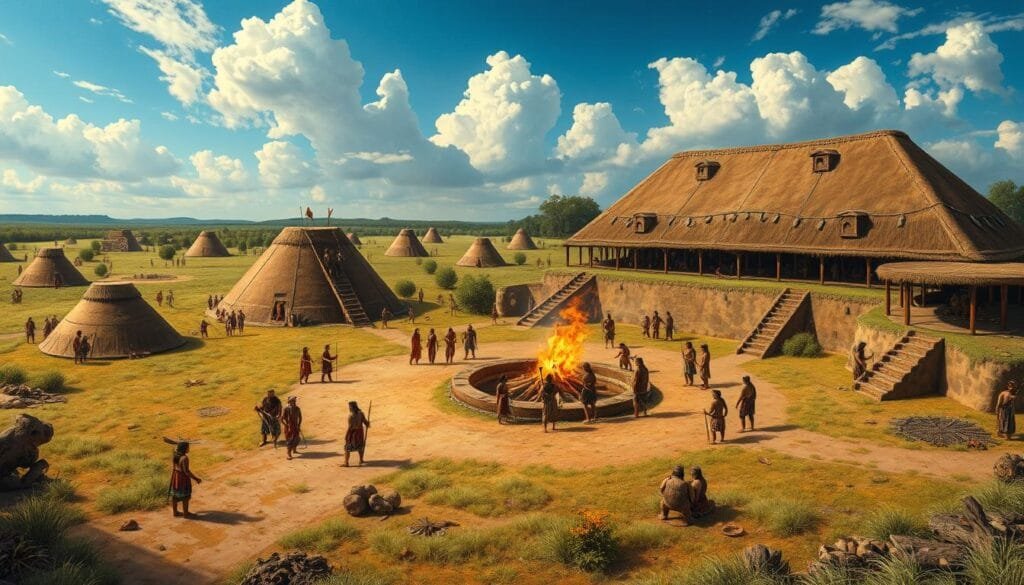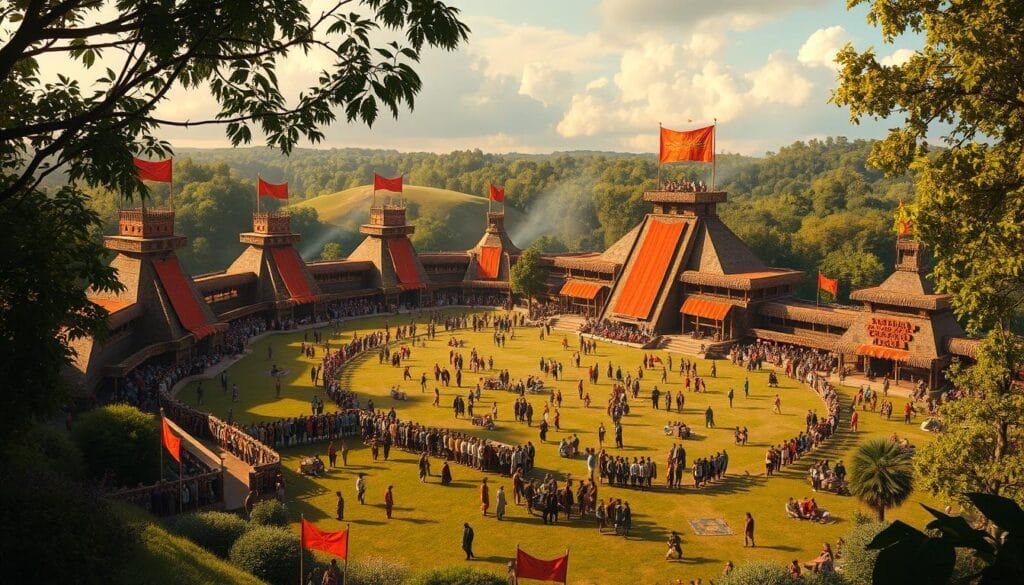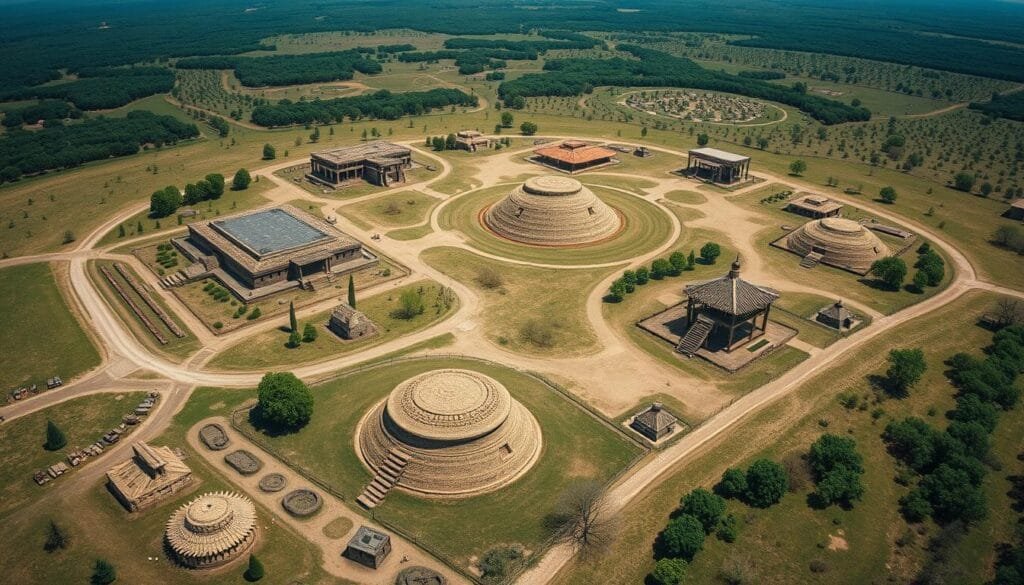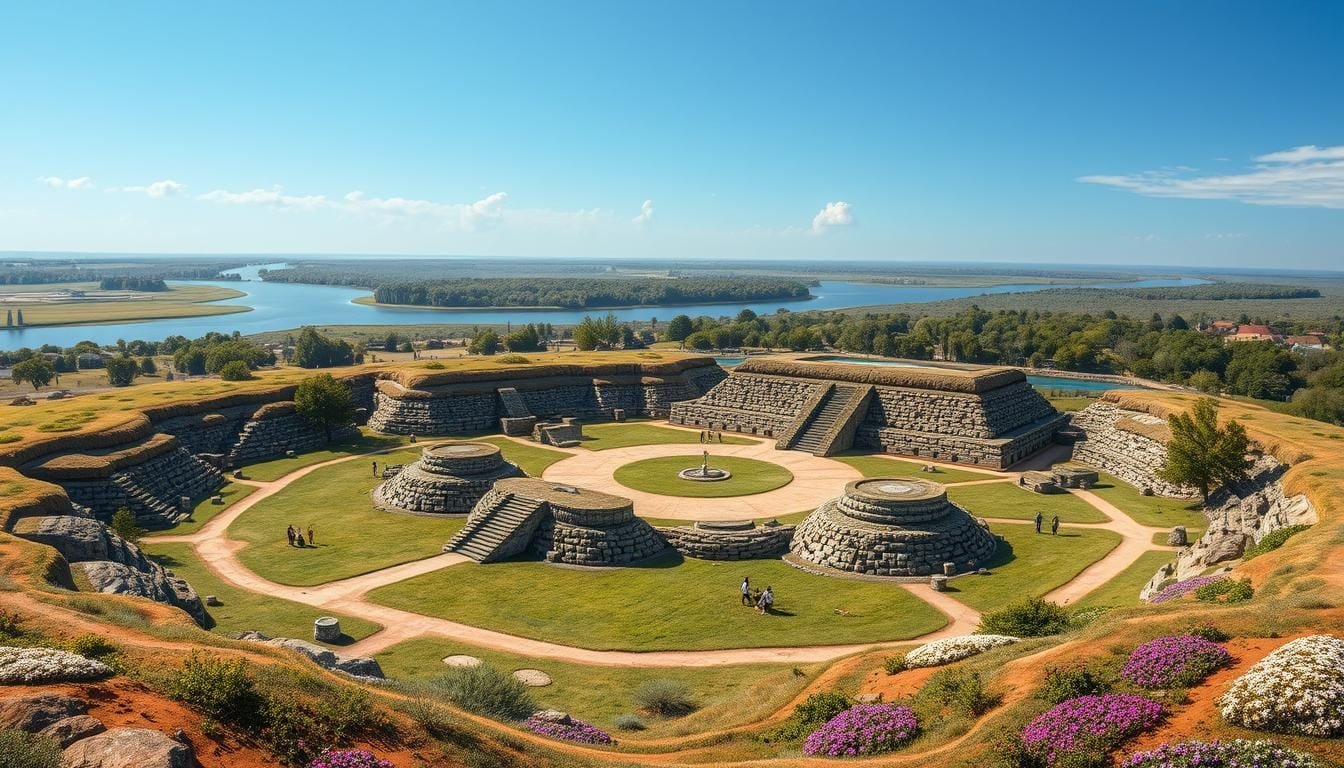Ever wondered about the role of open spaces in indigenous North American cultures? This article sheds light on the significance of plazas in Mississippian culture. This ancient civilization thrived from about A.D. 800 to 1600.
Plazas were far from empty. They were the community and ceremony’s core, showing a complex social and religious world. By examining the architecture and social importance of these plazas, we learn about a civilization whose cities spanned across what is now the United States.
Let’s uncover the secrets of these key gathering spots. We’ll look at their construction, purpose, and daily life around them. From large mounds to social ranks, we’ll see how these plazas were crucial for Mississippian culture to flourish.
Key Takeaways
- The Mississippian culture lasted from approximately A.D. 800 to 1600, spanning around 800 years.
- Plazas were central spaces used for various societal functions, including rituals and social gatherings.
- These central areas were typically surrounded by important communal and ceremonial buildings.
- Chiefdoms were the predominant social structure, with elites constituting a small percentage of the population.
- The largest earthwork, Monks Mound, stands as a testament to the architectural prowess of the Mississippian people.
Introduction to Mississippian Culture
The Mississippian culture flourished from about A.D. 800 to 1600. It mainly covered the Midwest and Southeast of today’s United States. This era is crucial for understanding early societies, showcasing their community, architecture, and farming progress.
Origin and Timeline
Around 1050 CE, the Mississippian culture began to grow more complex. It peaked from 1200 to 1500 CE. The start of extensive maize farming around 1000 CE was key for these communities. This era’s influence stretched wide, from early maize cultivation by the Caddo in 900 CE to advanced salt-making by 1650 CE.
Geographical Spread and Influence
Cahokia’s huge earthworks in Illinois mark the Mississippian culture’s extent. By 1200 CE, its mark was clear in places like Louisiana, known for its unique pottery. The Southeast, including Georgia and Tennessee, has many sites with Mississippian traits. The Dyar site in Georgia and Chucalissa Indian Village in Tennessee highlight this culture’s broad and lasting impact.
Below are some important points about the Mississippians’ spread and influence:
| Site | Location | Key Features | Period |
|---|---|---|---|
| Cahokia | Illinois | Largest Mississippian site | c. 1050-1350 CE |
| Angel Mounds | Indiana | Population of approximately 1,000 | c. 1050-1450 CE |
| Bottle Creek | Alabama | 18 platform mounds | 1250-1550 CE |
| Castalian Springs | Tennessee | 12 known mounds | 1000-1550 CE |
| Chucalissa Indian Village | Tennessee | Multiple periods of reoccupation | 1000-1550 CE |
What is a Plaza in Mississippian Culture
In Mississippian culture, a plaza is an open space in the heart of a village. It was a key spot for gatherings and activities. These places were more than just areas; they were the heart of community life for ceremonies and daily activities.

Mississippian plazas played a big role in the community’s social and political life. They were places where people could socialize every day or take part in big ceremonies. Activities that held religious meaning were often held here, making these plazas spiritually significant too.
The layout of these plazas showed the complexity of Mississippian societies. With the plaza at the center, villages were designed for gatherings, trading, and meetings. This design helped strengthen community ties and keep society together.
As Mississippian communities grew, they needed spaces like these plazas. The production of corn, beans, squash, and sunflowers led to larger populations. So, plazas turned into vital centers for community and spiritual life, showing the link between food, society, and religion.
Functions and Uses of Plazas
Mississippian settlements had plazas that were central to community life. They hosted ceremonies, social gatherings, and various activities. This helped strengthen the community ties.
Religious and Ceremonial Activities
Plazas in Mississippian societies were key religious centers. They were where religious rituals took place. These ceremonies showed the power of chiefs and united the community spiritually.
Evidence like that from Cahokia shows how vital these rituals were. Cahokia flourished around A.D. 1050 until it was left by 1400. These ceremonies were a big part of their culture.

Social Gatherings and Public Events
Plazas were not just for religion, they were also social hubs. They hosted markets, talks, and games. This made them key spots for social life.
Even though only a small part of Cahokia has been studied, we know plazas were important. The north plaza, for example, was always bustling. This was despite it usually being flooded.
| Aspect | Details |
|---|---|
| Duration of Cahokia | Established around A.D. 1050, inhabited for over 300 years, abandoned by 1400 |
| Extent of Excavation | Approximately 1% of the site excavated |
| North Plaza Conditions | Located at the lowest elevation, often inundated with water |
| Environmental Indicators | Soil samples suggest consistent wetland conditions year-round |
Plazas were rich, dynamic places. They brought together religious, social, and economic elements. This shows the complexity of Mississippian culture.
Architectural Features of Plazas
The plaza architecture of the Mississippian culture shows their advanced community layout and design. Plazas were central in these towns. They were set up for community and ceremonial purposes, showing society’s order and beliefs.

Layout and Design
At the heart of the community were the Mississippian plazas. They were encircled by platform mounds and living spaces. This setup, viewed at Mississippian building techniques, shows their planning skills. The plazas, usually rectangular, allowed for big gatherings. This layout appeared in many Mississippian sites, showing a common design strategy for community layout.
Surrounding Structures
Important buildings surrounded each plaza, standing on platform mounds. These included temples, elite residences, and offices. For example, Mound D at the Carson site was built in four stages. Stages II and III showed major ceremonial and political events. These mounds were central to society, showing social ranks.
The biggest earthwork before Columbus, Monks Mound, is over 100 feet tall. It was key for community and rituals, showing Mississippian culture’s essence. It gives us insight into their views and social setup.
Studies like sediment core analysis and radar have shown mounds were built in stages. They changed use over time, for gatherings and ceremonies. This shows that plaza architecture was crucial for their social and political lives. It defined Mississippian towns and holy places.
The Role of Plazas in Society
Plazas in Mississippian culture played many roles, not just as open spaces. They were vital centers for social, administrative, and political life. These areas were key for communal interactions and civic functions.
Central Gathering Points
Plazas were at the community’s heart, seen as social centers. They hosted social gatherings and public events. These spots saw everything from festivals and markets to ceremonies and performances.
Near Monks Mound, the presence of multiple plazas showed their role in society. Monks Mound is the largest structure of its kind in North America. This shows how plazas helped bond communities and express their culture.
Administrative and Political Influence
Plazas were not just for fun; they had crucial administrative roles. They held political meetings where leaders made key decisions. This likely showed who was in charge and how power was shared.
Excavations, like Caitlin Rankin’s at Cahokia’s north plaza, show how they were built and kept up. This highlights their practical and symbolic importance.
Plazas were more than open spaces, they were essential to Mississippian culture. They shaped the social, political, and administrative ways of life.
Notable Examples of Mississippian Plazas
The Mississippian culture thrived from A.D. 900 to 1700. It’s famous for its detailed and grand plazas. These areas were central to community life. The Etowah Indian Mounds and the Toltec Mounds Archeological State Park are prime examples. They show the complexity and importance of these ancient sites.
Etowah Mounds
The Etowah Indian Mounds are in Georgia. This site is well-kept and represents a key Mississippian site. It was founded around 1000 CE. It spans over 54 acres and includes six mounds.
The largest, Mound A, is 63 feet high. It likely hosted the chief’s home or a temple. The Funeral Mound, intriguingly, holds over 100 burials. Some graves are filled with fancy copper and shell decorations, showing the deceased’s high status. A central plaza was probably used for religious and public events, and community gatherings.
Toltec Mounds
Toltec Mounds Archeological State Park is in Arkansas. It features 18 mounds used between A.D. 650 and 1050. These mounds circle a vast plaza. This highlights the site’s role as a social and ceremonial center. The biggest mound is 49 feet tall, showcasing the Mississippian people’s ambitious architecture.
This park gives us a peek into the ceremonial and public life of these people. It demonstrates how important plazas were in their communities.
| Location | Main Features | Significance |
|---|---|---|
| Etowah Indian Mounds, Georgia | 6 Mounds, Central Plaza, Funeral Mound | Well-preserved site, high-status burials, platform mound architecture |
| Toltec Mounds Archeological State Park, Arkansas | 18 Mounds, Large Plaza | Strategic ceremonial layout, monumental efforts |
These ancient sites show the Mississippian culture’s architectural skill. They also tell us how crucial plazas were for community and ceremonies. Etowah Indian Mounds and Toltec Mounds Archeological State Park let us see the culture’s depth and spread. Exploring these places helps us understand the early communities of North America.
Conclusion
Studying Mississippian plazas helps us grasp the social and religious life of ancient North American societies. These spaces were more than just places. They were symbols that brought communities together, showing how important they were. For instance, Cahokia’s population reached up to 25,000 at its peak. This was as big as medieval London.
This growth, happening around A.D. 1050, shows how vital plazas were for their society. They called this growth the “Mississippian Big Bang.” It reveals the deep connection between communal spaces and the strength of their communities.
Places like Monks Mound were incredible. They covered 14 acres and were almost 100 feet tall. The large mounds show how much effort went into building these plazas. They were the heart of places like Cahokia, used for ceremonies, farming, trade, and government. This tells us how central plazas were to their civilization.
The link between the Mississippian and Plaquemine cultures, seen on this page, highlights their evolving traditions. This mix of cultures, forming by 1700 CE, shows their ability to adapt over time. By studying plazas, we get closer to understanding these ancient peoples. We see their innovations, how they changed, and their lasting impact on North American history.
FAQ
What is the Mississippian culture?
The Mississippian culture was a civilization of mound-building Native Americans. It thrived in the southeastern United States from about 800 CE to 1600 CE. They were known for their complex societies, farming practices, and large mounds.
What are ancient plazas in the context of Mississippian culture?
Ancient plazas in the Mississippian culture were communal spots for many activities. These areas were often the heart of the community. They were used for ceremonies, social events, and managing the community.
Where were Mississippian societies primarily located?
Mississippian societies made their homes across the southeastern United States. This includes what we now call Mississippi, Alabama, Georgia, and Arkansas. The land in these areas was rich and perfect for farming, helping large communities to grow.
What activities typically occurred in Mississippian plazas?
Mississippian plazas were important for many reasons. They hosted religious ceremonies, social meet-ups, public events, and more. These activities made plazas key places in the daily lives of these Indigenous peoples.
What architectural features are typical of Mississippian plazas?
Typical features of Mississippian plazas include a big open space in the middle. This space was surrounded by major buildings like mounds, temples, and houses. The design aimed to make a community space that was easy to use for different activities.
Can you name some notable examples of Mississippian plazas?
Two important Mississippian plazas are the Etowah Mounds in Georgia and the Toltec Mounds in Arkansas. These sites are well-preserved and provide a glimpse into the ceremonial and social lives of the Mississippian people.
